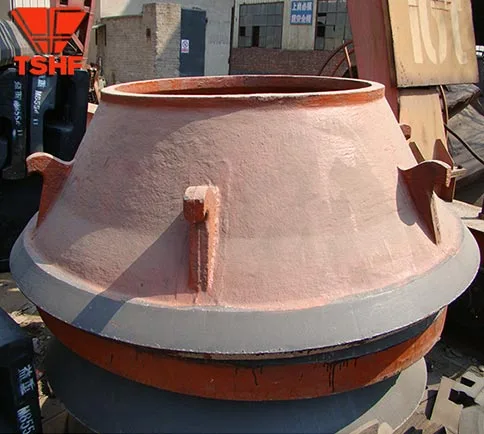Table of Contents
Introduction
Have you experienced unexpected downtime because your crusher ran without a critical part? Even a short stoppage can halt production lines and hit your bottom line. That’s why prudent operators stock essential Crusher Parts—minimal investment that maximizes uptime.
In this guide, you’ll discover which five components are must-haves, why they matter, and how proactive maintenance helps you stay ahead.
What exactly are Crusher Parts—and why should you pay attention?

Crusher Parts refers to the wear elements, components, and accessories that keep crushing machines operating reliably: jaw plates, liners, wear-resistant liners, eccentric shafts, bearings, belts, and more. Having strategic spares reduces emergency repairs, shipping waits, and unscheduled shutdowns—making your operation more resilient and competitive.
1. Jaw Plates and Liners – First line of protection
Jaw plates (in jaw crushers) and liners (in cone or impact crushers) are the front-line wear items. Made of manganese steel or wear-resistant composites, they endure crushing force day after day. Stocking high-quality jaw plates ensures:
- Consistent crushing capacity
- Even wear and longer service life
- Fast replacement during maintenance
Industry tests show when operators switch to premium jaw plates with proper backing, wear life extends 30–50%.
2. Mantle and Concave – Maintaining optimal throughput
In cone crushers, the mantle and concave take the brunt of material compressive force. Key considerations:
- Proper fit and alignment reduce premature wear
- Using alloy or multi-hardness liners improves efficiency and safety
- Regular visual inspection predicts worn spots before failure
Data from field trials show replacement before 80% wear maintains throughput and energy performance.
3. Bearings and Eccentric Shafts – Keep things spinning
Bearings and eccentric shafts are hidden dynamos. Bearings carry rotational loads, while eccentric shafts create crushing motion. Issues like vibration or grease failure can cause major problems—stocking spares and tools ensures:
- Smooth operation with reduced wear
- Quick recalibration during bearing change-outs
- Prevention of cascading failures
Engineers report that timely bearing replacement reduces downtime by up to 40% compared to reactive repairs.
4. Drive Belts and Couplings – Transmitting power reliably
Even minor slippage from worn drive belts or couplings can reduce crushing performance. Keeping a range of V-belts and flexible couplings helps maintain:
- Consistent power transmission
- Easy adjustment when tensioning belts
- Protection against misalignment via shock-absorbing couplings
Real-world operations note that preventative replacement every 6–12 months reduces production slowdowns.
5. Hydraulic Components – Fast, smooth regulation
Modern crushers rely on hydraulics—feed rate, tramp release, adjustment, and rotation controls. Essential hydraulic parts to stock:
- Seals and oil filters to prevent contamination
- Hydraulic pumps and cylinders for consistent actuation
- Control valves for precise system response
Well-maintained hydraulics reduce cycle time and prevent pressure spikes, especially during high-throughput shifts.
Mid-Section Table: Top Crusher Parts at a Glance
| Part Type | Function | Why It Matters |
|---|---|---|
| Jaw Plates/Liners | Crush raw material | First wear layer; affects output and particle shape |
| Mantle & Concave | Provide compressive crushing in cones | Ensures optimal throughput and wear life |
| Bearings & Shafts | Enable crushing motion | Avoids vibration, downtime |
| Belts & Couplings | Transmit drive force | Keeps power delivery smooth |
| Hydraulic Seals & Valves | Control crusher hydraulics | Maintains safety, performance, speed control |
Benefits of Acting Proactively

Keeping these five Crusher Parts in stock delivers:
- Reduced unplanned stops
- Predictable budgeting for maintenance
- Higher machine availability
- Better product quality with consistent operation
- Greater safety during part swaps
Studies confirm companies with spare-part programs report 20–30% fewer unplanned outages.
Implementing a Crusher Parts Inventory Strategy
Follow these steps to build an effective parts inventory:
- Track equipment runtime and generate wear data
- Analyze crusher usage patterns—batches, feed types, shifts
- Plan reorder points based on lead time
- Store parts in clean, dry environment with labels
- Train staff in quick-change procedures to reduce downtime
This systematic approach turns spare stocking into a competitive advantage.
Real Scenarios: How spare Crusher Parts save the day
- A quarry kept spare jaw liners and cut downtime in half during a planned outage.
- A recycling plant swapped a failed cone crusher bearing overnight, preventing a chain reaction shutdown.
- A heavy-duty concrete crushing operation avoided costly weekend stoppages by having hydraulic seals on standby.
These real-world examples highlight how smart planning turns spares into success.
Why Huifu is your trusted partner for Crusher Parts
Huifu offers:
- Large inventory of essential Crusher Parts ready for shipment
- On-site installation & preventive maintenance support
- Quality assurance on materials and workmanship
- Technical guidance to match part selection with your crusher type
- Full lifecycle service: installation, monitoring, and parts refresh
With Huifu, you get more than spare parts—you get continuity, performance, and peace of mind.
Conclusion
It’s a strategy. By proactively maintaining parts like jaw plates, liners, bearings, belts, and hydraulic components, you keep crushers running and operations consistent, safe, and profitable.
Are you ready to boost uptime and stabilize crusher performance? Contact Huifu today. We’ll help you create a spare-part plan that meets your uptime goals and budget.
FAQ
Which Crusher Parts wear out fastest?
Jaw and cone liners take the strongest beat and should be replaced when about 70–80% worn.
How many spare parts should I stock?
Begin with one full set of jaw or cone liners, bearings for critical shafts, a couple of drive belts, and a hydraulic seal kit.
Can used Crusher Parts work in a pinch?
Only if refurbished to factory specifications—otherwise they risk premature failure.
How often should parts be inspected?
Weekly visual inspections are recommended, with full inspections every 3–6 months depending on usage.
Does Huifu offer installation services?
Yes—we provide on-site installation and preventive maintenance instruction to help your team keep crushers running optimally.

